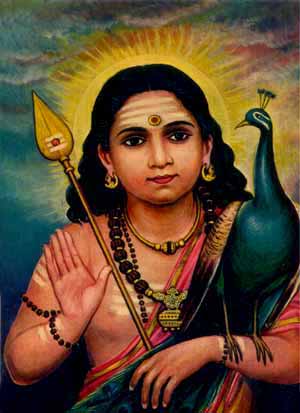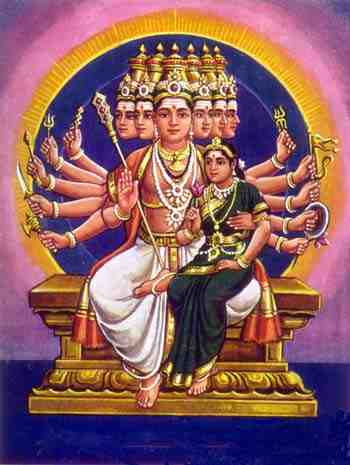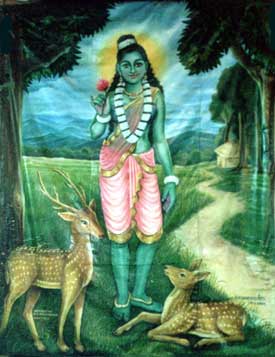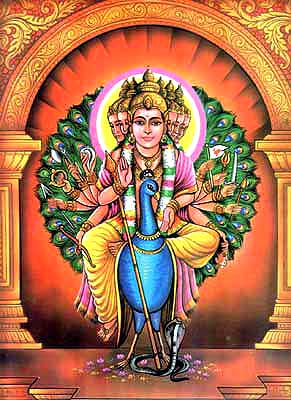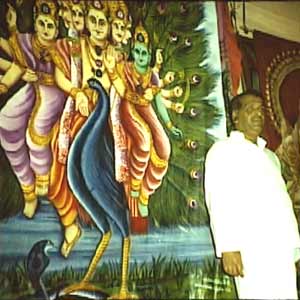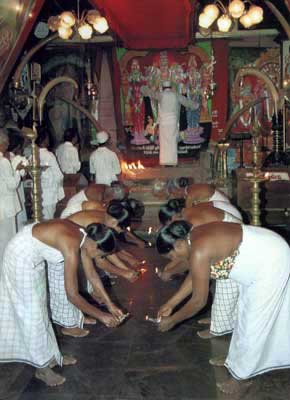|
| |||||||||||||||||||||||||
On the aspect of Kartikeya at Kataragama, Sri Lankaby Bharat Bhushan - bharatbhushan@yahoo.com
|

|
Lord Kataragama Skanda with Valli and Devasena |
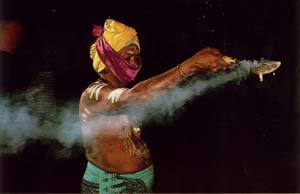
|

|
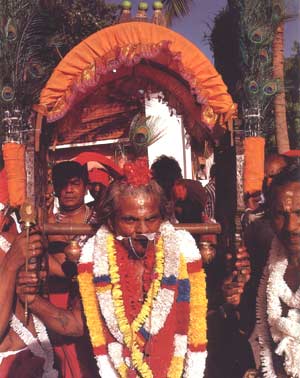 |
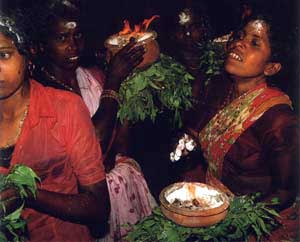
|
 |
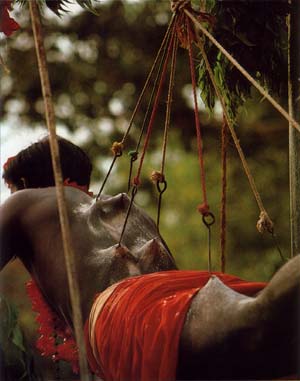
|
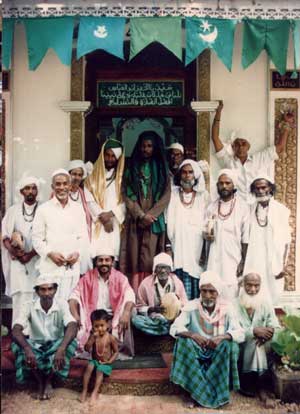 |
Kartikeya, the elder son of Shiva and Parvati, the war-general of the gods, the devas, is also known as Kataragama Deviyo in Sri Lanka and is venerated at Kataragama. The fast growing mofussil town of Kataragama, home to the Ruhuna Maha Kataragama Devalaya, is in the Monaragala District of Uva Province in Sri Lanka, about 230 kms south-east from Colombo. The region and the town was the seat of many kings of Sri Lanka. The temple is part of an extensive Hindu-Buddhist-Muslim group of religious shrines and visited by all communities, including the local ethnic Vedda people. The Kataragama temple was deep within the forests for many centuries and has become an easy-to-access place within the recent years. The roads have been widened, facilities increased, public and private transportation has been made easy and the numbers of pilgrims visiting the temple have gone up, more than exponentially. The much respected Kiri Vehera is an important Buddhist shrine, while Kartikeya is worshipped as Kataragama in the main shrine, and as Vel Murugan in a neighbouring shrine in the same compound. As in most similar places of pilgrimage for Shiva or Kartikeya in India or in Sri Lanka, thousands of pilgrims, Hindu and Sinhalese, reach Kataragama by walking for many days.
Pre-ancient history of Kataragama is more than 125,000 years, with evidence of Mesolithic and Neolithic settlements. Later, the place is first mentioned in history in the Mahavamsa written in 5th Century CE, as Kajjaragama about dignitaries arriving to receive the Bodhi sapling sent by the Mauryan Empire in 288 BC. The Ruhuna kings had chosen Kataragama as their capital city and sheltered here from the invasions by kings from South India. The royal presence concluded in the 13th Century CE. It is proposed by Paul Younger and Heinz Bechert that the worship of Kadiragamar was possibly begun by the local Vedda communities and was later taken up by Hindus and Buddhists.
The local priests at the Kataragama temple, known as kapuralas, are thought to be descendants from the Veddas, but that is yet to be confirmed. Kapuralas, meaning 'guardians of the camphor light', the offerings presented to Kartikeya, for being lighted at the temple, within the sanctum or in the premises outside. There are other shrines within the compound, quite proximate enough to be considered as being part of the main shrine. These are uniquely diverse, being Hindu, Buddhist, Islamic and also being in veneration to holy men who had been respected in the region.
Arunagirinathar on Kadiragamar or Kataragama Deviyo
A Tamil poet of the 15th century, in current Tamil Nadu, Arunagirinathar wrote the Tiruppugazh, a book of 16,000 songs in praise of Murugan or Kartikeya. About 1,365 poems are known, and the book is respected as an important work of Tamil literature. Born in Tiruvannamalai, at the sacred pilgrimage town to Shiva, he underwent a transformation in his life and behaviour and attempted to kill himself, and was thought to be saved by Murugan, who inspired him to become a saint. Subsequently, Arunagirinathar worshipped Murugan at Vedapureeswarar temple, at Cheyyar.
The poet-saint was one of the foremost among the acharyas of the Kaumaras who worship Kartikeya as the most supreme among all the gods. It is said that he indeed had the best of blessings of Kartikeya and could sing in complete expression of his devotion through rhythmic Thiruppugal songs. He wandered in devotion among the towers of the Arunachala temple at Tiruvannamalai, and sang in exquisite expression. Subsequently, he traveled about, singing in praise of Murugan, and devotees in other places and towns got to know of his songs and ability.
It is said that it was the poet-saint Arunagirinathar who visited the region in the 1400s and walked the entire pilgrimage route from Jaffna in northern Sri Lanka to Kataragama in the south. The poet-saint refers to Skanda-Murugan and confirms that the aspect of Kathirkamam at the top of the forested hill was Kartikeya. Composing the poems at the forest-deity of Khattugama, the poet-saint worshipped Kartikeya and declared the region as one of the most sacred. There are two important locations at Kataragama. The Kataragama Deviyo is at the foothill forests, while the Kartikeya and Shiva temples are at the top of the hill.
Early mention
There is mention of Kataragama Deviyo as Khattugama, and as a guardian deity of Sri Lanka in the Pali texts of Jinakalamali written in the 16th century in Thailand. The place is also listed in the Mahavamsa, and mentions that it was in Kataragama that the sacred Bodhi tree sapling from India was received during the reign of Asoka the great. There are different theories and aspects of the history of the temples and shrines at the location. The aspect of Skanda-Kumara or Kartikeya is also represented in the story of the meeting of Valli and Murugan in the region. It is however assumed that the temple and local region were recognised as sacred pilgrimage shrines much before the veneration by the poet-saint Arunagirinathar.
Much later, after the poet-saint Arunagirinathar, the place became known through the acclaimed veneration by Sri Kalyanagiri Swami from North India during 16-17th century C.E. He located and identified the aspects of the Skanda Purana with the various places at Kataragama. Subsequently, the numbers of Tamil and Sinhalese Hindu and Buddhist pilgrims increased in numbers. It is however to be noted that the pre-medieval aspect of Kartikeya at Kataragama was retained and respected mainly by the local Vedda communities. The local Kandyan kings of Sri Lanka ensured the prominence of Kataragama.
Kartikeya, Skanda or Murugan
The deity has many names including Kartikeya, Skanda, Murugan, Saravanabhava, Vel-Murugan, Subramaniam, Visakha, Mahasena or Shanmukhananda. He is the war-general of the gods, the 'god of war' himself. The aspect of Murugan or Murukan is known from various sources of literature, and there are several stories about the birth of Kartikeya, his battles with the asuras while leading the devas. A popular story is about the marriage of Kartikeya with Valli, an aboriginal Vedda girl. The Kanda Purana, thought to have been written in the 14th Century, presents the story of the meeting of Kartikeya with Valli.
There are several stories and tales of the aspect of Kartikeya coming to Sri Lanka and being accepted by all communities of the region. Several kings of Sri Lanka have worshipped the deity, including Dutthagamini (first century BCE) and Mahasena. It is said that it was Dutthagamini who constructed the shrine to Kartikeya at Kataragama. Other stories also explain that Kataragama was the deification of the King Mahasena who was born as a bodhisattva.
Muslim and Vedda legends
There are various Muslim or Islamic legends in the region. The ancient pre-Islam holy men in Kataragama were known as Khidr and the place was known as al-Khidr. The earliest Khidr is Hayathu, and his residence was later converted into a mosque. The Veddas are thought to retain their respect of Kataragama, but they would also worship the Kande Yakka or Gale Yakka as their important deity. Some rituals of worship for Kande Yakka has perhaps become part of the sacred rituals for Kartikeya at the Kataragama temple. The Veddas believe that Kartikeya was wedded to Valli, who was actually a local Vedda girl.
Pre-Sri Lanka, as the Generalissimo of the Gods
Kartikeya, as Murugan was known to be the war general of the gods in their battles against the asuras. Even Shiva was asked by the gods to accept his elder son as the supremo. There are several interesting stories to these situations. It is thus written that during the battles with Suryapadma, the leader of the asuras, Kartikeya went away to contemplate and plan the battles at six different locations in south India, and these are now recognised as pilgrimage sites. The six locations are Tiruttani, Swamimalai, Tiruvavinankudi or Palani, Pazhamudirsolai, Tirupparamkunram and Tiruchendur. These locations were described and rendered in the collection of Tamil poems of the Sangam period (c. 3 AD) - Tirumurugaatruppadai - and are now known as - Aarupaadai Veedu [six war camps] of Kartikeya who was also known thereby as Devasenapati [General of the army of the devas].
Kartikeya at Kataragama, or Katirkamam, is also known as Kathiravel, apart from Kataragama Deviyo (= Lord of Kataragama). The courtship story with Valli, being a local ethnic - possibly Vedda - woman, represents that the supreme deity, the war-general of the gods himself, was in love and married a commoner. The Kataragama temple, along with the Nallur Kandaswamy temple, Maviddapuram Kandaswamy temple and the Sella Channithy temple are the prominent temples to Kartikeya in Sri Lanka. Apart from Kataragama, the other temples are in Jaffna. Sinhala Buddhist thought seems to have accepted Kartikeya at Kataragama as a guardian deity, while most rituals at the temple have origins in aspects of Vedda prayers.
References
- Kartikeyan, (1990): Kanthar Anubhuti (God-Experience) of Saint Arunagirinathar. 2nd ed. India: Divine Life Society.
- Rao, T. A. G. (1985): Elements of Hindu Iconography. Vol. II. Delhi.
Courtesy: Journal of Knowledge Sciences
| Living Heritage Trust ©2021 All Rights Reserved |
